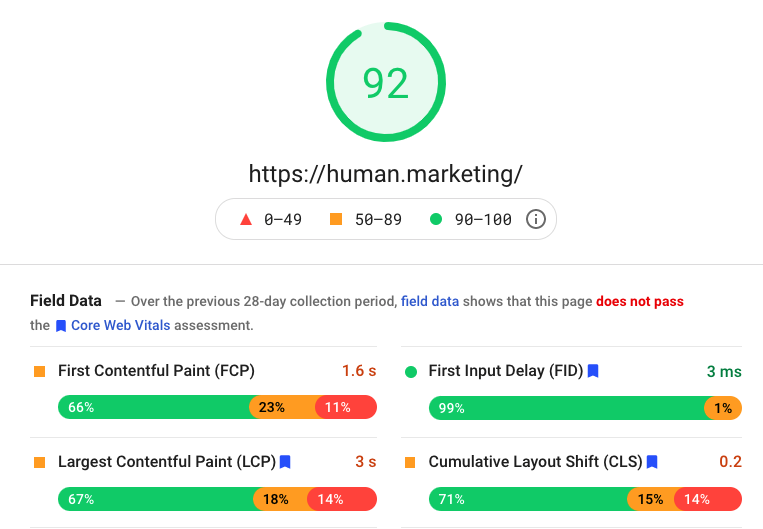You pump out new blog posts every week. After all, consistently publishing SEO-friendly content drives more website visitors, email subscribers and revenue. The problem is: only a handful of blog posts generate organic traffic.
Organic search accounts for more than 70% of traffic to business services websites. And blogging is one of the best ways to grow your online authority and traffic.
So how do you make every blog post count — and avoid wasting time on content that doesn’t get results?
Applying these simple SEO tips every time will help you increase blog traffic:
- Focus on Producing Less, Higher Quality Content
- Improve Your Internal Link Strategy
- Nail Your Topic With Thorough Keyword Research
- Optimize the Blog for Your Keyword
- Fix Critical Page Speed and Mobile Friendliness Issues
- Promote Your Blog Posts
- Update and Improve Blog Posts Often
Need expert content marketing help? Reach out to Human today.
1. Focus on Producing Less, Higher Quality Content
Content produces traffic. So more content should equate to more traffic, right?
Not always.
The important distinction here is “quality.” Publishing multiple blog posts a week won’t generate much traffic unless the content is high-quality and just plain better than the competition.
So what exactly does “quality” mean?
To create content that gets ranked above the competition, you should strive to write blog content that is:
- Thorough and satisfies the search intent: Delivers on the search intent and answers related questions users might have. Typically longer in length.
- Well-researched and reputable: Includes credible sources and relevant data (when applicable).
- Organized and easy to navigate: The information is laid out so readers can quickly consume the content and answer their questions. It includes visuals, subheads, bullets and short paragraphs.
- Highly readable: How easily can users read and understand your text? Tools like Grammarly score you on readability. Quality blog content has a high readability score, meaning it’s easy to consume and error-free.
- High-converting: Gets someone to take the next step, which signals your content is compelling and trustworthy to search engines.
While “quality” is subjective, analytics can help ground your analysis in data.
Of course, rankings and organic traffic are the first sign of high-quality content. But as you move up the SERPs, you can also look to behavioral metrics like time on page and bounce rate to quantify how compelling your content is.
Before publishing your blog, thoroughly research competitors to make sure you have the best resource available on the topic. Ultimately, the most useful, accurate and engaging content will prevail.
Free Download: 4 Steps For Producing Great Content That Search Engines Will Love
2. Improve Your Internal Linking Strategy
Internal links help drive readers to related posts where they can learn more about the topic. When done correctly, an internal linking strategy helps organize your content, directing search engines to your most important pages.
When publishing blogs, look for natural opportunities to link between posts.
If you’ve defined a topic cluster strategy, check to make sure the blog links to its pillar page and related pages within the cluster.
Tools like Blueprint SEO help you manage your topic cluster strategy and see where links don’t exist in your topic cluster.
Showing relationships between your content via links helps search engines understand your topical “expertise” and points them to high-value pages to surface in the results page (helping you earn more rankings and visibility!)
Plus, this gives readers more opportunities to find and engage with your content — increasing traffic to your blogs.
3. Nail Your Topic With Thorough Keyword Research
The topic and keywords you target directly affect how much organic traffic your blog post generates. It’s an essential SEO task that should inform the content you produce.
But it’s not as easy as selecting a keyword, inserting it into your blog and ranking. Topic and keyword research inform your blog structure and content. And mastering this step is a blend of art and science.
First, let’s understand what we mean by “topic” and “keywords.”
- Topic: The focus of your article — the promise you intend to deliver on to your readers.
- Keywords: All the related search phrases around your topic, informed by SEO research.
Keyword Research 101:
Once you have a topic in mind, conduct keyword research to validate your ideas with data and compile a list of keywords to target in your article.
- Spy on competitors. Use SEO tools like Moz or Semrush to evaluate top-ranking competitors. Which keywords do their blog rank for that you should also target? What are their best-performing keywords (those that drive the most traffic or have the highest conversion potential)?
- Target keywords you have the potential to rank for. Is your site new or struggling with low domain authority? New websites haven’t built the trust to rank highly for keywords thousands of people search for monthly. Instead, targeting longer-tail keywords can help you build some initial traffic and momentum. Do a quick Google search — if page 1 is stacked with reputable sources, the keyword is probably a long shot, or you’ll need to invest extra time into making that blog post exceptional.
- Compile primary and secondary keywords. Only focusing on one keyword is a missed opportunity. What about all the related subtopics that you could touch on in the article? During your research, compile a list of your primary and secondary keywords to help guide the writing process and ensure every section of your blog aligns with actual user search trends.
- Think from the user’s perspective. This is where your own brainpower comes in. Imagine you were searching for this topic — what information would you expect to see? How would you prefer to consume it? Use these answers as jumping-off points for additional keyword research to round out your topic.
- Don’t compete with yourself. Search engines understand how words and phrases relate — that’s why keywords like “how to stop sweat” and “tips to reduce sweat” return similar results. Creating separate blog posts for each keyword only confuses search engines and prevents your page from getting found. When selecting keywords, make sure you haven’t written on a similar topic.
4. Optimize the Page for Your Keyword
The days when keyword density would earn you a top organic position are long gone.
But that doesn’t mean keywords are dead.
Including a target keyword in your metadata and content is still important for reinforcing what your content is about.
Once you’ve selected a primary keyword, include that phrase in the metadata on your page:
- URL: Include your keyword phrase in the URL. Keep it short, and exclude filler words.
- Meta title: This is the headline that appears in search results. Search engines like Google cut off your title after 70 characters. Naturally incorporate your keyword target in the meta title, but keep it within this character limit.
- Meta description: The meta description is a 160-character summary of your page that appears below your meta title in search results. Although not a major ranking factor, it's what entices readers to click through to your page. Meta descriptions that include the search keyword appear bolded in search results, so it's smart to include your keyword here.
- H1: Every blog post should have one keyword-driven H1 defined per page.
- H2s: These are your primary section headers on the page. Where relevant, include your target keyword in these headers.
- Image alt tags: Add an image that speaks to your topic, and incorporate the SEO keyword target in the alt tag to reinforce the topic of your page.
Not sure if your blog post is missing these critical SEO elements?
Install the Google extension Open SEO Stats, and you'll see exactly what Google does on any webpage. Other inbound marketing tools like Moz and Yoast WordPress plugin also offer this insight.
5. Fix Critical Page Speed and Mobile Friendliness Issues
Google’s mission is to make information accessible and useful.
A slow-loading or mobile-unfriendly blog layout interferes with the user experience — something Google no longer stands for.
That’s why Google introduced its newest page experience criteria — Core Web Vitals — which measures “ how users perceive the experience of interacting with a web page beyond its pure information value.”
If your blog loads slowly or measures poorly against these criteria, your organic rankings and traffic could also suffer.
Track your blog’s page speed and core web vitals scores using Google’s PageSpeed insights. While these fixes require some development legwork, you can get a head start on what to fix with a Page Experience audit. 
6. Promote Your Blog Posts
Once you hit publish, it could take months for your blog post to move up the search engine results.
Give your blog post instant visibility by promoting it across your social channels and to your email list. Getting readers to engage with your blog is an important trust signal to search engines that can help it move up the SERPs faster.
You can also boost blog posts that segue nicely into your services with some paid spend to get in front of new audiences (and drive new leads).
Get our ultimate guide to content promotion here.
7. Update and Improve Blog Posts Often
We know that search algorithms aim to deliver the most accurate, up-to-date information.
A fast, effective way to drive blog traffic is to keep your content fresh.
By updating your blog content to better answer the search query, you improve what exists and signal that the content is current, giving you a potential boost in rankings.
Blog Optimization 101:
Here’s how to identify opportunities to improve your blog content and increase traffic:
- Research existing keyword traction. Use tools like Moz’s Keyword Explorer to see which keywords your blog currently ranks for so you can double-down on the traction you’ve already built.
- Audit the SERPs. The SERPs reveal clues about the topics and information search engines look for in content. Get inspiration for your blog post by reviewing these sections of the SERP:
- Featured snippet: Does one exist? Can you improve your content to earn this position?
- “People Also Ask”: What additional questions could you answer in your content to get featured in this section?
- Related searches: Are there related searches that could inspire new topics to cover in your blog?
- Evaluate the top-ranking pages. Go back to your blog research stage and investigate the top 1-5 pages currently ranking for your keyword target. Ask:
- What keywords do these pages rank for that you don’t?
- What information do these pages offer that yours is missing?
- What critical information do these pages lack?
- Are there any new industry updates or research you could add?
- Strive to be the best representation of the topic. Ultimately, growing traffic comes down to offering the best content that fully satisfies the search intent. Sure, this requires extra time and research. But having the most helpful content out there is the best thing you can do to improve rankings and increase blog traffic.
- Update the publish date. After giving your content a well-deserved makeover, update the publish date to reinforce the “freshness” of your content.
Few people regularly update their blog posts. If you run a technical blog — where information changes with every new product release or update — you have plenty of opportunities to update your content and leapfrog competitors.
Looking for more? Get our step-by-step content optimization guide.
Blog Optimization: The Best-Kept Secret to Increase Blog Traffic
At Human, we’ve found that blog optimization is hands-down the best way to drive organic traffic and build website authority.
By regularly polishing your content with up-to-date research, related information or improved readability, you show search engines you’re committed to keeping content fresh.
Of course, you shouldn't abandon your new content development efforts. But dedicating a few hours a week to revamping underperforming blog posts will dramatically improve their ranking potential and organic traffic to your blogs.
Struggling to drive traffic to your blogs? Learn how Human helped one company increase blog traffic by 1,500% in 6 months.



